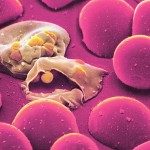Lien vers Pubmed [PMID] – 17641635
Nat Protoc 2007;2(7):1705-12
The initial phase of malaria infection is the pre-erythrocytic phase, which begins when parasites are injected by the mosquito into the dermis and ends when parasites are released from hepatocytes into the blood. We present here a protocol for the in vivo imaging of GFP-expressing sporozoites in the dermis of rodents, using the combination of a high-speed spinning-disk confocal microscope and a high-speed charge-coupled device (CCD) camera permitting rapid in vivo acquisitions. The steps of this protocol indicate how to infect mice through the bite of infected Anopheles stephensi mosquitoes, record the sporozoites’ fate in the mouse ear and to present the data as maximum-fluorescence-intensity projections, time-lapse representations and movie clips. This protocol permits investigating the various aspects of sporozoite behavior in a quantitative manner, such as motility in the matrix, cell traversal, crossing the endothelial barrier of both blood and lymphatic vessels and intravascular gliding. Applied to genetically modified parasites and/or mice, these imaging techniques should be useful for studying the cellular and molecular bases of Plasmodium sporozoite infection in vivo.





